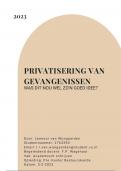Samenvatting
Samenvatting hoorcolleges Microbiologie - BMW UvA, jaar 3 ()
- Vak
- Instelling
Uitgebreide samenvatting (103 blz.) van alle hoorcolleges ter voorbereiding van het theorie tentamen Microbiologie. Omvat alle tentamenstof voor de drie deelonderwerpen: bacteriologie, virologie, en parasitologie. Begrippen en concepten zijn uitgebreid toegelicht en bijbehorende figuren zijn hierbi...
[Meer zien]












